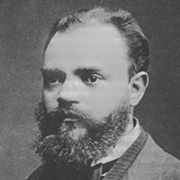Bärenreiter Praha is publishing the A minor Violin Concerto and the Slavonic Rhapsodies, two works which urgently needed new editions.
Antonín Dvořák, Violin Concerto in A minor op. 53 (B 108)
The new edition of Dvořák’s Violin Concerto op. 53, prepared by Iacopo Cividini, an expert on Dvořák’s instrumental concertos and scholar at the Salzburg Mozarteum, reflects in detail the complicated compositional process, from the first sketches in 1879 to the last revision which culminated in the edition published by Simrock in spring 1883.
The history of the concerto is basically a story of negotiations with the violinist Joseph Joachim, whose contributions as an adviser during the genesis of the work are beyond doubt, although he himself never performed the work in public. Cividini identifies seven different phases of composition and revision in the autograph score of the concerto, and four phrases of editorial work on the manuscript, which preceded the printed edition. This detailed analysis reveals the development of Dvořák’s intentions and makes it possible to better trace to what extent these were realised in the first printed edition. As well as the printed score, the printed orchestral parts, solo part and piano reduction have also been taken into consideration; Cividini’s assumption is that Dvořák supplied manuscripts for these in his own hand. However, these sources were evidently not subject to all the stages of correction, and thus the printed orchestral parts and the piano reduction do not reflect the last version of the music text. The piano reduction, probably Dvořák’s own, had to be corrected in our edition; after more than 130 years this now includes corrections which had never been incorporated, so it now corresponds with the full score.
Dvořák’s own fingering for the solo violin is printed in the full score and solo part, whereas Joachim’s numerous other fingerings are now documented in the piano reduction for comparison purposes. The edition offers a few passages in the solo part, which Joachim simplified technically with Dvořák’s knowledge, in both variants – the original based on the autograph manuscript, and the simplified one given as an ossia version based on the Simrock edition. One further interesting feature of the new critical edition is the careful differentiation of the articulation and the length of dynamic markings with reference to the autograph. Based on his thorough familiarity with Dvořák’s notation and the specific editorial problems, Iacopo Cividini has considerably added to our knowledge of this work.
Jonáš Hájek
Antonín Dvořák, Slavonic Rhapsodies op. 45 (B 86)
Antonín Dvořák composed the Slavonic Rhapsodies for large orchestra in 1878, and although they were written and subsequently published under the same opus number, these were three independent compositions which appeared in sketches, scores and piano duet arrangements throughout the year, a year in which incidentally the composer was also preoccupied with other works on a Slavic theme (the Slavonic Dances op. 46, and String Quartet op. 51, known as the “Slavonic”). With their folksong-like nuancing, the three Rhapsodies in D major, G minor and A flat major represent a sort of orchestral counterpart to the Moravian Duets op. 20, 29, 32 and 38, the success of which Dvořák tried to build on, something which the publisher Fritz Simrock encouraged him to do.
Dvořák conducted the first two Slavonic Rhapsodies at their premiere in autumn 1878, in his first fully-fledged concert at which he presented himself to the Prague audience as composer and conductor; numerous further performances followed. In most cases the pieces were performed individually, that is, not as a cycle. Although the Slavonic Rhapsodies were amongst Dvořák’s most frequently-performed works during his lifetime, which also contributed considerably to his first successes abroad, they are now only occasionally performed in concerts.
The works were first published in 1879 by Simrock in Berlin, and the only subsequent edition is as part of the Complete Critical Edition of the Works of Antonín Dvořák in 1959, an edition which does not comply with modern requirements in many respects. The new edition by the American musicologist Robert Simon takes the first printed edition as its starting point, and this is then compared with the autograph manuscript. This contributes to a more complex view of the composer whose “Slavic” period should be evaluated not only on the basis of his notoriously well-known Slavonic Dances.
Eva Velická
(from [t]akte 1/2017)
(translation: Elizabeth Robinson)



